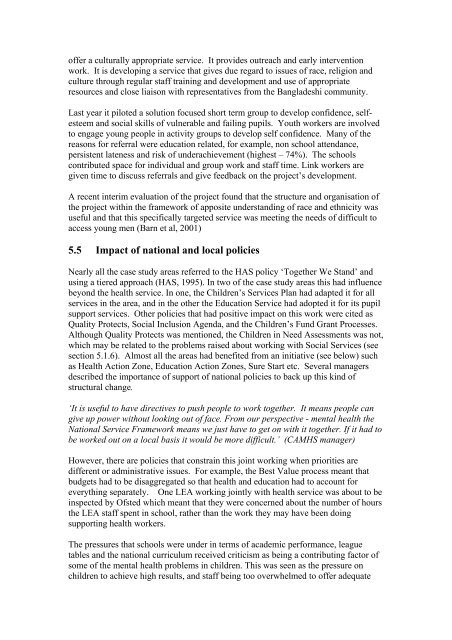(CAMHS) and Schools - London Health Programmes
(CAMHS) and Schools - London Health Programmes
(CAMHS) and Schools - London Health Programmes
You also want an ePaper? Increase the reach of your titles
YUMPU automatically turns print PDFs into web optimized ePapers that Google loves.
offer a culturally appropriate service. It provides outreach <strong>and</strong> early intervention<br />
work. It is developing a service that gives due regard to issues of race, religion <strong>and</strong><br />
culture through regular staff training <strong>and</strong> development <strong>and</strong> use of appropriate<br />
resources <strong>and</strong> close liaison with representatives from the Bangladeshi community.<br />
Last year it piloted a solution focused short term group to develop confidence, selfesteem<br />
<strong>and</strong> social skills of vulnerable <strong>and</strong> failing pupils. Youth workers are involved<br />
to engage young people in activity groups to develop self confidence. Many of the<br />
reasons for referral were education related, for example, non school attendance,<br />
persistent lateness <strong>and</strong> risk of underachievement (highest – 74%). The schools<br />
contributed space for individual <strong>and</strong> group work <strong>and</strong> staff time. Link workers are<br />
given time to discuss referrals <strong>and</strong> give feedback on the project’s development.<br />
A recent interim evaluation of the project found that the structure <strong>and</strong> organisation of<br />
the project within the framework of apposite underst<strong>and</strong>ing of race <strong>and</strong> ethnicity was<br />
useful <strong>and</strong> that this specifically targeted service was meeting the needs of difficult to<br />
access young men (Barn et al, 2001)<br />
5.5 Impact of national <strong>and</strong> local policies<br />
Nearly all the case study areas referred to the HAS policy ‘Together We St<strong>and</strong>’ <strong>and</strong><br />
using a tiered approach (HAS, 1995). In two of the case study areas this had influence<br />
beyond the health service. In one, the Children’s Services Plan had adapted it for all<br />
services in the area, <strong>and</strong> in the other the Education Service had adopted it for its pupil<br />
support services. Other policies that had positive impact on this work were cited as<br />
Quality Protects, Social Inclusion Agenda, <strong>and</strong> the Children’s Fund Grant Processes.<br />
Although Quality Protects was mentioned, the Children in Need Assessments was not,<br />
which may be related to the problems raised about working with Social Services (see<br />
section 5.1.6). Almost all the areas had benefited from an initiative (see below) such<br />
as <strong>Health</strong> Action Zone, Education Action Zones, Sure Start etc. Several managers<br />
described the importance of support of national policies to back up this kind of<br />
structural change.<br />
‘It is useful to have directives to push people to work together. It means people can<br />
give up power without looking out of face. From our perspective - mental health the<br />
National Service Framework means we just have to get on with it together. If it had to<br />
be worked out on a local basis it would be more difficult.’ (<strong>CAMHS</strong> manager)<br />
However, there are policies that constrain this joint working when priorities are<br />
different or administrative issues. For example, the Best Value process meant that<br />
budgets had to be disaggregated so that health <strong>and</strong> education had to account for<br />
everything separately. One LEA working jointly with health service was about to be<br />
inspected by Ofsted which meant that they were concerned about the number of hours<br />
the LEA staff spent in school, rather than the work they may have been doing<br />
supporting health workers.<br />
The pressures that schools were under in terms of academic performance, league<br />
tables <strong>and</strong> the national curriculum received criticism as being a contributing factor of<br />
some of the mental health problems in children. This was seen as the pressure on<br />
children to achieve high results, <strong>and</strong> staff being too overwhelmed to offer adequate

















